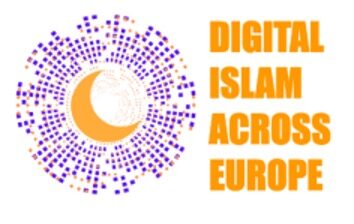Gary R Bunt (UK Team and Website data analysis)
Anna Grasso (UK Team and Website data analysis)
This collection is part of the Digital Islam Across Europe project’s archive. One of the DigitIslam project outputs focuses on website data and collection analysis. The objective is to identify, catalogue and analyse Muslim organisations’ and actors’ websites (Online Islamic Environments or OIEs) from these different countries.1
This collection focuses on websites set up or focused on Muslim influential online figures in the United Kingdom. Despite the predominant use of social media (Facebook, Twitter, Instagram…), in many cases, Muslim public personalities chose to set up their own digital platforms. These individuals could be described as ‘influencers’, although care should be taken in universally applying this term: it has the sense of an individual whose online activities and behaviour can impact the activities and worldviews of others, including those who choose to identify, follow and network with that individual. Not only can a substantial online audience be monetised by an influential individual (and their organisation), but it can help fulfil religious, political, social and other objectives.2
Whether the individuals listed would describe themselves as ‘influencers’ is open to question, as the term can also have negative connotations. Web pages may attract different types of readers, with greater depth of articles than shorter posts on social media platforms allowing greater reader engagement; web pages will be picked up in different ways by search engines and their associated algorithms, determining the visibility of an author or influencer. This can also be predicated on page design, coding, and search engine optimisation – as important in terms of audience acquisition as the content of any web page or post. The archive shows that some individuals have higher levels of engagement with their audiences, and post with a frequency that encourages return visits and affiliation. Subscription and membership options can also enhance allegiance and affiliation, especially if levels of interaction and engagement are offered by content providers.3
These individuals are influential in different sectors going from religious authority figures (Sunni, Shia, Sufi, or Ahmadiyya Muslims) to activists (defending political, feminist, minority and other causes) passing by famous converts, invested researchers, journalists, writers, artists, counsellors, and bloggers. The websites listed here form part of a wider online space, incorporating social media (beyond the scope of our archive). They act as essential hubs for online activities and sustained records of digital discourse, which forms part of an influential subtext of opinion, discourse and rhetoric across Muslim diversity. The archive (and screenshots in this article) demonstrate that breadth.
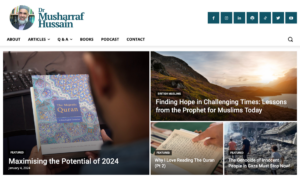
Website of Dr. Musharraf Hussain – Sunni Muslim scholar
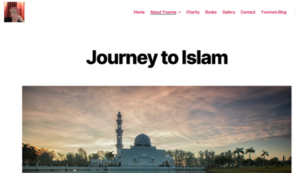
Website of Yvonne Ridley – British journalist and convert to Islam
Websites are used for presenting themselves and their work. Some of these actors set up these online spaces to provide specific services (courses, Q&A, pilgrimage guidance, therapies, counselling, marriage services, charities, online shop…).
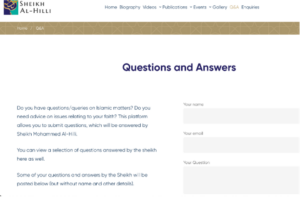
Website of Shia Sheikh Al-Hilli providing a Q&A section
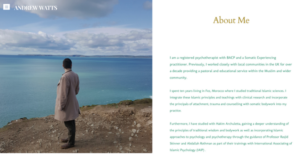
Website of Andrew (Idriss) Watts presenting his counselling and psychotherapist services
Others chose to develop it more as a blog with written or visual material displaying their vision with regard to faith, current events, fashion, lifestyle as well as other subjects.
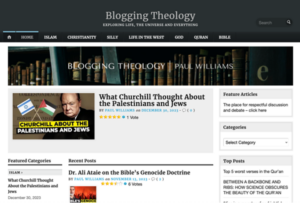
Paul Williams’ blog discussing topics around Islam, theology, current events, etc.
Some of these pages are no longer updated yet we found it equally compelling to save them as they contain interesting posts in relation to the context in which they were written in.
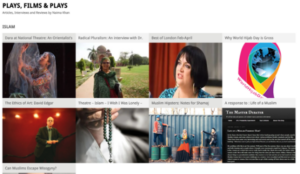
Naima Khan – director of the Inclusive Mosque Initiative – held a blog covering subjects such as gender and Islam
Moreover, they provide insights into how the use of online tools has evolved over time.
This archive consists of an initial capture. We will be updating this list in due course. We believe this data can become a useful tool for researchers and the general public who have an interest in digital Islam across Europe as well as those who are mostly focused on the study of Islam or comparative religion within the British or Western context. Moreover, the analysis of these sites will be part of a wider project output through presentations and publications.
- For more information on this: https://blogs.ed.ac.uk/digitalislameurope/research-findings/archiving/ back
- Definitions of “Influencers” and “Influences” are explored in-depth in Gary R. Bunt, Islamic Algorithms, (New York and London, Bloomsbury, 2024) back
- Gary R. Bunt, Hashtag Islam, (Chapel Hill: University of North Carolina Press, 2018). 66-72 back
Image by fancycrave1 from Pixabay
